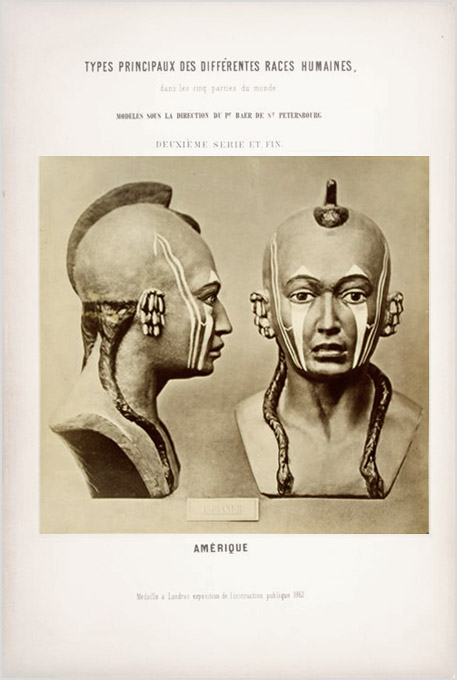
[St.-Pétersbourg] : Kaiserliche Akademie der Wissenschaften, 1862.
Description : 2-parts in 1 ; 8 p., [5 l.] pl. & [7 l.] pl. ; ill.: 12 phot. ; 51 cm.
Photographs : albumens mounted on printed boards, representing papier-mâché busts.
Photographer : Heuser Werkstatt (workshop).
Subject : Head — Comparative eidonomy ; anthropography.
Notes :

On September 24, 1861, Baer and Rudolf Wagner (1805-1864) invited the world's leading craniologists to unite behind the goal of codifying a universal system for measuring and representing human skulls. The meeting was held at University of Göttingen where Wagner had succeeded the father of modern anthropology, Johann Friedrich Blumenbach (1752-1840). Wagner curated Blumenbach's rich collection of skulls cabineted at the Theatrum Anatomicum, including the five iconic skulls that established his subdivisions (Variatäten) of human race (Caucasian, Mongolian, Ethiopian, American, Malaysian), and which set the course of comparative anthropology to this day. Participants discussed methods of imaging crania, highlighting recent advances in photography. The published report of the proceedings was illustrated by lithographic views of three skulls–brachycephalic, dolichocephalic, and mixed–drawn from photographs that were formatted by Baer according to his recommendations to the assembly.* The photographing of live subjects was also touched upon, with commentary on shaving the heads of indigenes, referencing the photographic labors of "Herr Sewenzow" in Kyrgestan. I was unable to find a photographer with this name, or the alternative spellings Severzow and Sévertsof (Baer, 1862), but this was probably a photographer attached to the General von Kaufman (1818–82) commission, tasked with mapping and chronicling imperial Russia's expansion into the Turkestan region.
The 1861 meeting was also a chance to reassert Germany's importance in the field of anthropology which was then overshadowed by the French school. Baer's magnificent elephant folio appeared one year later, more as a splashy tour-de-force than an example of the scientific precision opportuned by a camera in combination with a cephalometer, or even as a supplement to the Wagner & Baer report. The 81 Heyser busts, eventually numbering 150, are wonderful. They demonstrate beautifully that cargo culting is a phenomenological exercise at every level of sophistication in human civilizations, including the august halls of academia.
The name Heuser is sometimes inscribed as Baer's co-author in bibliographies. In anglophone works the name is spelled Heyser, although for the 1862 London exhibition catalogs his name is written, Heiser: "588-HEISER, H., Manufacturer. St. Petersburg. Figures in papier-maché: Five ethnological tables, representing the human races." Besides the photographic plates, there are also notices in contemporary German texts offering copies of the busts for sale, "unbreakable and on a black polished wooden base," along with other papier-mâché items such as aeroliths and zoological models. I was unable to discover the name of the photographer, but given the large output of the Heyser Workshop –they also manufactured manikins–it is possible there was an in-house operator to photograph product and send images to prospective clients. By the 1870's the Heyser firm was renamed Schindhelm's Workshop.
*Baer, Karl Ernst & Wagner, Rudolph (1861), "Bericht über die Zusammenkunft einiger Anthropologen im September 1861 in Göttingen zum Zwecke gemeinsamer Besprechungen." Leipzig: Leopold Voss ; 1861.
